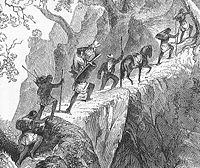
Tumpline
Encyclopedia

A tumpline is a strap
Strap
A strap, sometimes also called strop, is an elongated flap or ribbon, usually of fabric or leather.Thin straps are used as part of clothing or baggage, or bedding such as a sleeping bag. See for example spaghetti strap, shoulder strap...
attached at both ends to a sack, backpack
Backpack
A backpack is, in its simplest form, a cloth sack carried on one's back and secured with two straps that go over the shoulders, but there can be exceptions...
, or other luggage
Luggage
Baggage is any number of bags, cases and containers which hold a traveller's articles during transit.Luggage is more or less the same concept as "baggage", but is normally used in relation to the personal luggage of a specific person or persons Baggage is any number of bags, cases and containers...
and used to carry the object by placing the strap over the top of the head. This utilizes the spine
Vertebral column
In human anatomy, the vertebral column is a column usually consisting of 24 articulating vertebrae, and 9 fused vertebrae in the sacrum and the coccyx. It is situated in the dorsal aspect of the torso, separated by intervertebral discs...
rather than the shoulder
Shoulder
The human shoulder is made up of three bones: the clavicle , the scapula , and the humerus as well as associated muscles, ligaments and tendons. The articulations between the bones of the shoulder make up the shoulder joints. The major joint of the shoulder is the glenohumeral joint, which...
s as standard backpack straps do. Tumplines are not intended to be worn over the forehead, but rather the top of the head just back from the hairline, pulling straight down in alignment with the spine. The bearer then leans forward, allowing the back to help support the load.
Tumplines are often used to transport heavy loads across uneven terrain such as footpaths
Trail
A trail is a path with a rough beaten or dirt/stone surface used for travel. Trails may be for use only by walkers and in some places are the main access route to remote settlements...
and portage
Portage
Portage or portaging refers to the practice of carrying watercraft or cargo over land to avoid river obstacles, or between two bodies of water. A place where this carrying occurs is also called a portage; a person doing the carrying is called a porter.The English word portage is derived from the...
s. The voyageurs
Voyageurs
The Voyageurs were the persons who engaged in the transportation of furs by canoe during the fur trade era. Voyageur is a French word which literally translates to "traveler"...
of the North America
North America
North America is a continent wholly within the Northern Hemisphere and almost wholly within the Western Hemisphere. It is also considered a northern subcontinent of the Americas...
n fur trade
Fur trade
The fur trade is a worldwide industry dealing in the acquisition and sale of animal fur. Since the establishment of world market for in the early modern period furs of boreal, polar and cold temperate mammalian animals have been the most valued...
used tumplines exclusively to carry their cargo of pelts and rations across portages.
Backpacks for the military and recreational campers were redesigned to carry larger loads during the middle and late twentieth century, and tumplines have become less common in the developed world.
The Indians in Mexico (and other Latin American countries) traditionally have used the tumpline for carrying heavy loads, such as firewood, baskets (including baskets loaded with construction materials and dirt for building), bird cages, and furniture. In the 1920s there was a man in Mexico City who delivered pianos on his back using a tumpline. In Mexico a common name for tumpline is "mecapal". Modern highland Mayans of southern Mexico use tumplines for various pedestrian transport.

